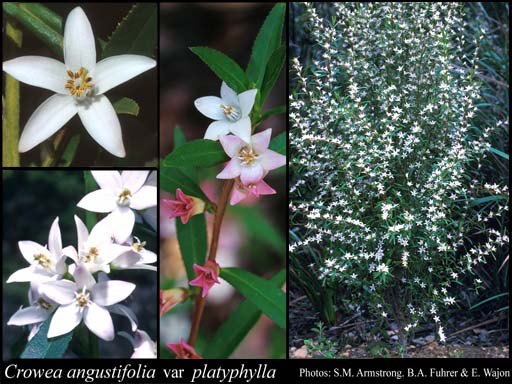- Reference
- Fl.Austral. 1:330 (1863)
- Conservation Code
- Not threatened
- Naturalised Status
- Native to Western Australia
- Name Status
- Current
Erect or spreading shrub, 0.3-3.5 m high, leaves elliptic to obovate. Fl. pink/white, Sep to Dec. Sandy, gravelly soils. Granite outcrops & slopes.

Scientific Description
Shrub, spines absent; branchlets smooth, without distinct raised glands, +/- cylindrical in cross-section, glabrous. Leaves alternate, simple, 30-45 mm long, 3-12 mm wide, flat, smooth, without distinct raised glands, covered in hairs or scales, with stellate (star shaped) hairs; stipular excrescences absent. Flowers axillary, solitary; pedicels 3.5-4.5 mm long; calyx present, 3-5 mm long, smooth, without distinct raised glands, glabrous; corolla pink or white or cream, petals five, 10-16 mm long, imbricate (overlapping), glabrous; stamens twice as many as petals, 5-7 mm long, smooth, ciliate (with a marginal fringe of hairs); anthers 2-3.4 mm long, without an appendage. Flowers in September, October, November and December. Occurs in the South-West Botanical Province, in the Jarrah Forest, Warren, Esperance and Swan Coastal Plain IBRA region(s).
Distribution
- IBRA Regions
- Avon Wheatbelt, Esperance Plains, Jarrah Forest, Warren.
- IBRA Subregions
- Fitzgerald, Katanning, Southern Jarrah Forest, Warren.
- IMCRA Regions
- WA South Coast.
- Local Government Areas (LGAs)
- Albany, Cranbrook, Denmark, Manjimup, Nannup, Plantagenet.